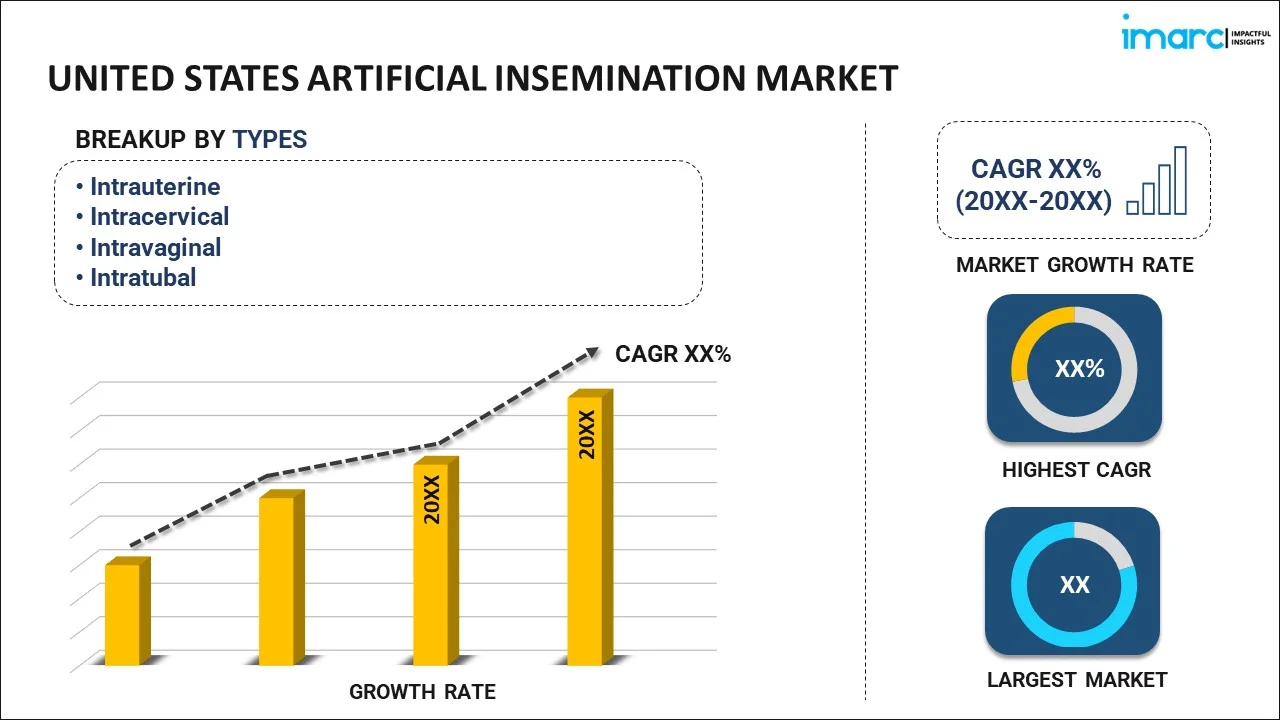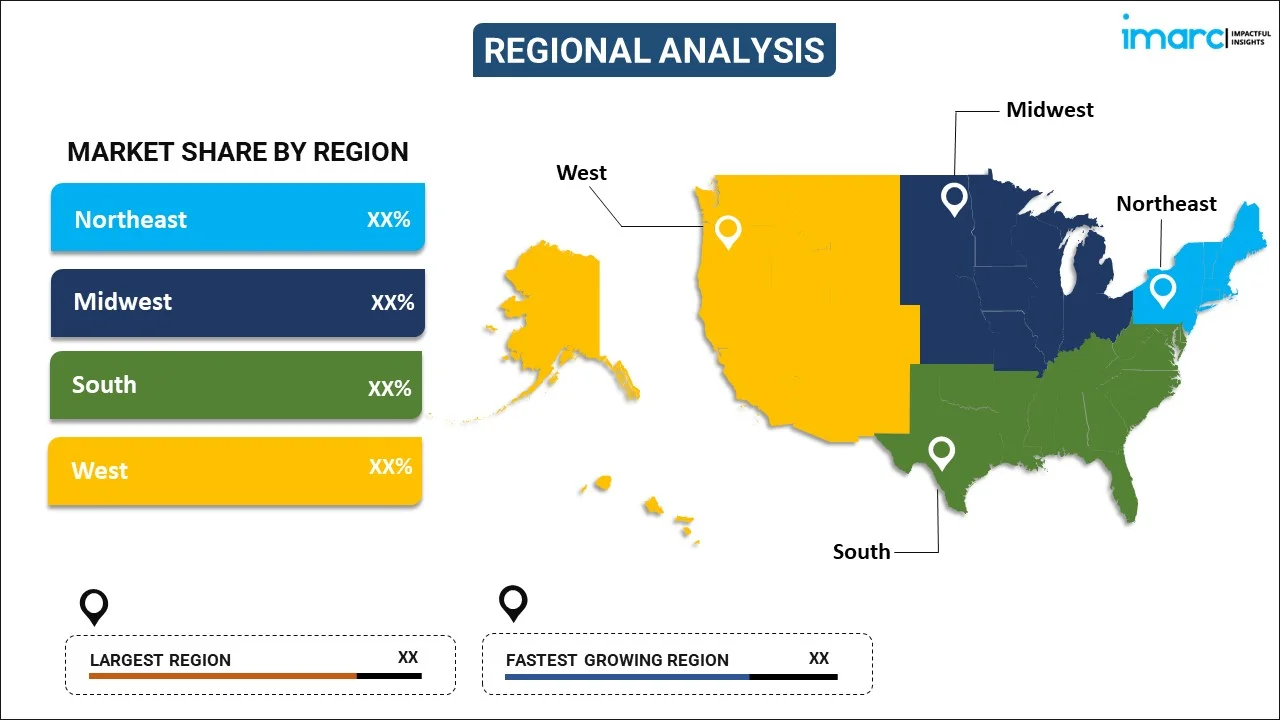
United States Artificial Insemination Market Report by Type (Intrauterine, Intracervical, Intravaginal, Intratubal), Source Type (AIH-Husband, AID-Donor), End Use (Hospitals and Clinics, Fertility Centers, and Others), and Region 2025-2033
Market Overview:
The United States artificial insemination market size is projected to exhibit a growth rate (CAGR) of 7.20% during 2025-2033. The growing adoption among single individuals or same-sex couples to achieve pregnancy, rising demand for less invasive and more cost-effective approach as compared to other complex fertility treatments, and increasing awareness about artificial insemination among individuals represent some of the key factors driving the market.
|
Report Attribute
|
Key Statistics
|
|---|---|
|
Base Year
|
2024 |
|
Forecast Years
|
2025-2033 |
|
Historical Years
|
2019-2024
|
| Market Growth Rate (2025-2033) | 7.20% |
Artificial insemination is an advanced reproductive technique used in humans to facilitate fertilization without the need for natural mating. It comprises collecting semen from a male, known as the sire or the donor, and then introducing it into the reproductive tract of a female, known as the dam or the recipient. It is a less invasive and more accessible fertility option and assists in promoting genetic diversity within the population while helping individuals or couples overcome fertility challenges. It aids in increasing the chances of conception and prevents the transmission of certain genetic disorders among individuals. Besides this, it increases the chances of sperm reaching the egg of a women and bypasses the cervical barrier. As it aids in enhancing desirable traits, such as disease resistance and growth rate, the demand for artificial insemination is rising in the United States.
United States Artificial Insemination Market Trends:
At present, the increasing adoption of artificial insemination, as it increases the chances of successful fertilization and reduces the risk of transmitting sexually transmitted infections (STIs) and diseases among individuals, represents one of the primary factors impelling the growth of the market in the United States. In line with this, the growing demand for artificial insemination for more efficient reproduction cycles and higher conception rates is offering a positive market outlook in the country. Apart from this, the increasing utilization of artificial insemination due to low sperm count, poor sperm motility, or other sperm-related issues among the male population is supporting the growth of the market in the United States. In addition, there is a rise in the demand for artificial insemination to increase the chances of fertilization by directly placing a higher amount of healthy sperm near the eggs in women. This, coupled with the increasing adoption of artificial insemination, as it is less invasive and more cost-effective approach compared to other complex fertility treatments, such as in vitro fertilization (IVF)., is strengthening the growth of the market in the United States. Besides this, the growing demand for artificial insemination on account of the rising awareness about artificial insemination among the masses is positively influencing the market in the country. Additionally, the increasing utilization of artificial insemination, as it enables single individuals or same-sex couples to achieve pregnancy, is offering lucrative growth opportunities to industry investors in the United States. Furthermore, the rising adoption of artificial insemination due to the increasing prevalence of cervical problems in women, is bolstering the growth of the market in the country.
United States Artificial Insemination Market Segmentation:
IMARC Group provides an analysis of the key trends in each segment of the United States artificial insemination market report, along with forecasts at the country level for 2025-2033. Our report has categorized the market based on type, source type, and end use.
Type Insights:

- Intrauterine
- Intracervical
- Intravaginal
- Intratubal
The report has provided a detailed breakup and analysis of the market based on the type. This includes intrauterine, intracervical, intravaginal, and intratubal.
Source Type Insights:
- AIH-Husband
- AID-Donor
A detailed breakup and analysis of the market based on the source type has also been provided in the report. This includes AIH-husband and AID-donor.
End Use Insights:
- Hospitals and Clinics
- Fertility Centers
- Others
A detailed breakup and analysis of the market based on the end use has also been provided in the report. This includes hospitals and clinics, fertility centers, and others.
Regional Insights:

- Northeast
- Midwest
- South
- West
The report has also provided a comprehensive analysis of all the major regional markets, which include Northeast, Midwest, South, and West.
Competitive Landscape:
The report has also provided a comprehensive analysis of the competitive landscape in the United States artificial insemination market. Competitive analysis such as market structure, key player positioning, top winning strategies, competitive dashboard, and company evaluation quadrant has been covered in the report. Also, detailed profiles of all major companies have been provided.
United States Artificial Insemination Market Report Coverage:
| Report Features | Details |
|---|---|
| Base Year of the Analysis | 2024 |
| Historical Period | 2019-2024 |
| Forecast Period | 2025-2033 |
| Units | Million USD |
| Scope of the Report | Exploration of Historical and Forecast Trends, Industry Catalysts and Challenges, Segment-Wise Historical and Predictive Market Assessment:
|
| Types Covered | Intrauterine, Intracervical, Intravaginal, Intratubal |
| Source Types Covered | AIH-Husband, AID-Donor |
| End Uses Covered | Hospitals and Clinics, Fertility Centers, Others |
| Regions Covered | Northeast, Midwest, South, and West |
| Customization Scope | 10% Free Customization |
| Post-Sale Analyst Support | 10-12 Weeks |
| Delivery Format | PDF and Excel through Email (We can also provide the editable version of the report in PPT/Word format on special request) |
Key Questions Answered in This Report:
- How has the United States artificial insemination market performed so far and how will it perform in the coming years?
- What has been the impact of COVID-19 on the United States artificial insemination market?
- What is the breakup of the United States artificial insemination market on the basis of type?
- What is the breakup of the United States artificial insemination market on the basis of source type?
- What is the breakup of the United States artificial insemination market on the basis of end use?
- What are the various stages in the value chain of the United States artificial insemination market?
- What are the key driving factors and challenges in the United States artificial insemination market?
- What is the structure of the United States artificial insemination market and who are the key players?
- What is the degree of competition in the United States artificial insemination market?
Key Benefits for Stakeholders:
- IMARC’s report offers a comprehensive quantitative analysis of various market segments, historical and current market trends, market forecasts, and dynamics of the United States artificial insemination market from 2019-2033.
- The research study provides the latest information on the market drivers, challenges, and opportunities in the United States artificial insemination market.
- Porter's five forces analysis assist stakeholders in assessing the impact of new entrants, competitive rivalry, supplier power, buyer power, and the threat of substitution. It helps stakeholders to analyze the level of competition within the United States artificial insemination industry and its attractiveness.
- Competitive landscape allows stakeholders to understand their competitive environment and provides an insight into the current positions of key players in the market.
Need more help?
- Speak to our experienced analysts for insights on the current market scenarios.
- Include additional segments and countries to customize the report as per your requirement.
- Gain an unparalleled competitive advantage in your domain by understanding how to utilize the report and positively impacting your operations and revenue.
- For further assistance, please connect with our analysts.
 Inquire Before Buying
Inquire Before Buying
 Speak to an Analyst
Speak to an Analyst
 Request Brochure
Request Brochure
 Request Customization
Request Customization




.webp)




.webp)












